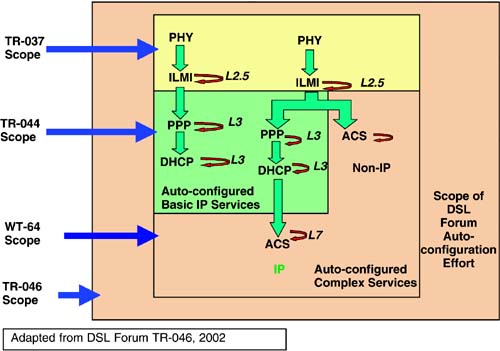13.4 The DSL Forum Framework for Autoconfiguration
| DSL Forum TR-46 [10] describes a progressive configuration architecture for DSL CPE. Figure 13.3, adapted from TR-46, provides an overview of the Forum's framework for autoconfiguration. Figure 13.3. Autoconfiguration framework from DSL Forum TR-046. As with the scheme illustrated in Figure 13.2, the DSL Forum architecture assumes that the autoconfiguration progresses both up the stack and into the network. The Forum's autoconfiguration scheme then divides the space of CPE into three categories:
In all cases listed in Figure 13.3, the DSL PHY is assumed to provide tools within its own initialization protocol to automatically exchange the information required to allow the DSL path to initialize between the customer's premises and the provider's network. In those cases where ATM is used as the link layer, the ILMI (ATM Forum af-ilmi-065.0000 [1]) is used to transport the ATM configuration parameters between the network and the CPE. Extensions to the ILMI MIBs (management information bases) have been defined specifically to support DSL interfaces. These additions to the ILMI are defined in ATM Forum af-nm-0122.000 [2] af-nm-0165.0000 [3] and DSL Forum TR-37 [8]. Once the physical DSL connection and the ATM layer have been configured in the CPE, communications are possible to the equipment that supports standard IP stack tools to configure the IP parameters in the DSL CPE. In the case of "simple" IP environments, PPP and DHCP provided the necessary information to the CPE. In more complex environments, the two protocols are not sufficient to configure the CPE, and additional interfaces are required which are categorized in the DSL Forum's framework as ACS interfaces. The non-IP architectures cannot use IP-based tools to configure the environment at the customer premises. Specialized ACS will be used to transport the service parameters to the CPE. An example of such an ACS is the configuration and management interfaces being defined for loop extension voice-over DSL (voice-over ATM) by the ATM Forum. 13.4.1 Use of ILMI to Configure the ATM Layer in a DSL EnvironmentTR-37 describes the use of the ATM ILMI, which provides the parameters that the CPE needs to use ATM virtual circuits to communicate over the DSL network. The ILMI [1] is an interface provided over the ATM protocols to allow configuration of the ATM interface on the link between two pieces of network equipment. The ILMI uses a specific ATM virtual circuit (VPI = 0, VCI = 9) to carry the SNMP management protocol between the equipment at each side of the link. The SNMP messages are directly carried on the ATM cell stream; no IP is required to support ILMI. SNMP MIBs, specifically designed for the configuration of ATM interfaces, are communicated over the SNMP interface provided by the ILMI. In addition to the ATM-specific MIBs defined in ATM Forum af-ilmi-065.0000, DSL-specific ILMI MIBs have been defined in ATM Forum Recommendations af-nm-0122.000 [2] and af-nm-0165.000 [3]. The following information must be provided to the CPE in order to allow it to utilize the ATM services provided by the network:
The ILMI- and DSL-specific MIBs allow transport of this information to the DSL CPE. All information except the encapsulation and the L2 and L3 client protocols are known to the "owner" of the ATM network, the NAP (the "access network realm" in Figure 13.1). This information would be configured into the ATM network and DSLAM when the user's service is configured. The encapsulation and L2 and L3 protocols are, in general, determined by the service provider, the NSP (the "service provider realm" in Figure 13.1). The NSP must be able to communicate these to the NAP to allow the NAP to configure the ATM interface. 13.4.2 Configuring the Basic IP EnvironmentOnce the initialization and configuration of the ATM layer is complete, the CPE is aware of which protocols are transported at Layer 3 of the stack on each ATM VC and the specific encapsulation used. For most IP environments, either PPP or DHCP or both may then be used to configure the appropriate IP parameters. DSL Forum TR-44 [9] discusses the use of these protocols in a DSL environment. Table 13.1 lists the appropriate configuration protocols for each of the commonly implemented IP architectures used over DSL. (These architectures are discussed in Chapter 14.) PPP [4] allows the CPE to receive the following information from the network regarding the IP parameters:
PPP also supports the exchange of the authorization information used to identify and authorize the user's access to the NSP's network. DHCP [6] allows the dynamic assignment of IP addresses and IP subnet masks by the network to the CPE. Ethernet is a shared environment and the PPP protocol assumes a single PPP session is implemented on a point-to-point link, therefore an additional identifier is required to separate the multiple PPP sessions on LAN and ATM VC. This PPPoE session ID maps each PPPoE message to a particular end point on the Ethernet LAN. PPPoE utilizes a specialized initialization protocol to assign these IDs [7]. 13.4.3 Complex IP Environments and Non-IP EnvironmentsNeither DCP nor PPP allow for the configuration of features such as firewalls, complex routing rules, or network address translation (NAT) tables on the CPE. Additionally, in some service models the ability to configure arbitrary applications at the customer's site from the network is desirable. Proposals for interfaces to support these complex configurations include the development of specialized SNMP MIBs, the use of LDAP [5], and the development of specialized configuration protocols. Similarly, non-IP “based services cannot be configured using tools such as PPP or DHCP. Certain applications such as voice-over DSL have their own configuration and management interfaces defined. In other cases, application-specific configuration interfaces may have to be developed. However, the same tools can be used for configuring the physical and ATM layers of all DSL CPE for both complex and simple higher-layer environments. Table 13.1. IP Initialization Protocols Used with Common ATM-based End-to-End Architectures
|
| Top |
EAN: 2147483647
Pages: 154
